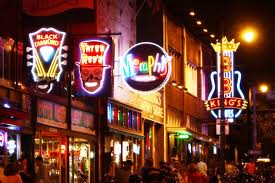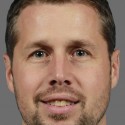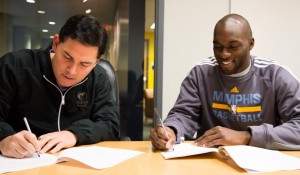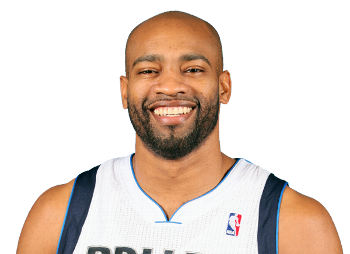 The Memphis Grizzlies begin the 2014-15 season with high hopes. With the core in place and an exceptionally deep bench,
The Memphis Grizzlies begin the 2014-15 season with high hopes. With the core in place and an exceptionally deep bench,  making a return to the Western Conference finals – or further – is the goal.
making a return to the Western Conference finals – or further – is the goal.
Last season, the injury bug bit the Grizzlies. Multiple key players missed extended time, and the Grizzlies couldn’t separate themselves in the West as a result.
Ending the season contemplating what could have been is unpleasant, and it’s a situation the Grizzlies don’t care to find themselves in for the second straight season. If they can stay healthy and play up to their potential, old, familiar scars will remain closed. Their win total is projected at 48 1/2, and plenty of folks out there are keying on this as a bet to be looked at closely.
Here are five things to watch as the Grizzlies chase the Larry O’Brien Trophy.
1. What kind of owner is Robert Pera? After essentially revamping the entire front office without warning during the offseason, all eyes are on Robert Pera going forward. Nobody seemed to know anything was wrong until May 19, when Pera fired then CEO Jason Levien and assistant GM Stu Lash. A great deal of uncertainty surrounded those moves, and at one point it looked like a move to Minnesota was a foregone conclusion for Grizzlies coach Dave Joerger.
 Anybody that challenges Michael Jordan to a game of 1-on-1 is perhaps not the most sane person, and some of Pera’s odd decisions certainly have Grizz Nation wondering aloud where this is all headed with him at the helm. Over the course of his ownership tenure, Pera’s done some bizarre things – allegedly suggested making Mike Miller a player-coach, challenged Tony Allen to a game of 1-on-1, conducted player exit interviews by himself, held a Twitter session to address questions about the front office moves rather than going through traditional media channels, etc.
Anybody that challenges Michael Jordan to a game of 1-on-1 is perhaps not the most sane person, and some of Pera’s odd decisions certainly have Grizz Nation wondering aloud where this is all headed with him at the helm. Over the course of his ownership tenure, Pera’s done some bizarre things – allegedly suggested making Mike Miller a player-coach, challenged Tony Allen to a game of 1-on-1, conducted player exit interviews by himself, held a Twitter session to address questions about the front office moves rather than going through traditional media channels, etc.
Despite the laundry list of strange things Pera has done as owner, the man is not stupid. You don’t build a massive tech company (Ubiquiti Networks) before you turn 30 without being exceptionally bright. He was levelheaded enough to realize Levien had made solid personnel moves and those people should be kept around. Joerger, VP of Basketball Operations John Hollinger and President of Business Operations Jason Wexler were all retained, and that adds at least a bit of stabilization.
All that we really know about Pera entering his third season as owner is that we don’t know anything him. He remains a mystery man, who up to this point has been content to remain in the background while letting others conduct the serious business of the organization on the ground in Memphis. Now that he plans to be far more active in all decisions, will we finally learn who this guy is?
2. How will Dave Joerger handle his crowded backcourt? There are a finite number of minutes to be allocated in an NBA game. The roster is flush with wing players, and all of them can’t get the court time they might deserve and definitely want. Tony Allen, Vince Carter, Courtney Lee, Quincy Pondexter, Tayshaun Prince and rookie Jordan Adams are all vying for minutes on the wing. It will be tough for Joerger to optimize his lineups with this logjam.
Allen, Carter, Lee and Pondexter will all likely have a chance to start some games this season, and nobody knows heading  into the season which two will have emerged as the starting wings by the end of the season. Joerger, entering just his second season as a coach, still has a lot to learn about game management. Figuring out the backcourt rotation will be a massive test for him and will play a big part in determining the Grizzlies’ overall success this season.
into the season which two will have emerged as the starting wings by the end of the season. Joerger, entering just his second season as a coach, still has a lot to learn about game management. Figuring out the backcourt rotation will be a massive test for him and will play a big part in determining the Grizzlies’ overall success this season.
Additionally, the front office under Pera’s ownership has been nothing but shrewd and proactive in their decision-making, so it wouldn’t be the least bit surprising if a trade materializes sending at least one of the aforementioned players out of Memphis. That might be the best solution to make managing the rotation a much less daunting task for Joerger.
3. Will Quincy Pondexter rebound from his injury? Quincy Pondexter’s 2013-14 season was nothing short of a disaster. It was cut short after he suffered a stress fracture in his right foot in early December. However, the woes didn’t start there. Before the point of his injury, he had firmly cemented himself in Joerger’s doghouse.
 In the 15 games Pondexter was active before his injury, he had four DNP-CDs. He didn’t take it well, evidenced by the infamous staredown with Joerger during the middle of a game against Brooklyn when the basket seemingly turned into an ocean for the small forward.
In the 15 games Pondexter was active before his injury, he had four DNP-CDs. He didn’t take it well, evidenced by the infamous staredown with Joerger during the middle of a game against Brooklyn when the basket seemingly turned into an ocean for the small forward.
For the Grizzlies to build on their recent success, they will need Joerger and Pondexter to have worked out their differences and for Pondexter to return to his 2012-13 form that earned him a four-year, $14 million contract extension.
If Pondexter can stay healthy and be the 3-and-D role player he was two seasons ago, the Grizzlies will have much better spacing offensively and an even more suffocating defense. If he continues to play like he did last season, the Grizzlies could struggle to separate themselves from the pack once again in the brutal West.
RELATED: Grizzlies salaries and analysis
4. How will the rookies fare? Entering the season, both Jordan Adams and Jarnell Stokes are on the outside looking in with regard to playing time. Adams is behind a plethora of wing players, and Stokes is competing against Jon Leuer for minutes as the backup power forward.
Statistical models love Adams and Stokes, and that likely played a huge role in the team’s decision to draft them. The rookies had strong Summer League performances, and they will have a chance to further prove their current value in preseason games. Even with good play, though, it will be tough for them to break into the regular season rotation.
The most likely scenario for either guy to get extended court time would be if an injury occurred. Nobody wishes for that, but it is nice for the Grizzlies to have Adams and Stokes waiting in the wings to step up.
it is nice for the Grizzlies to have Adams and Stokes waiting in the wings to step up.
5. How will Vince Carter fit in? Over the course of his career, Vince Carter has played for five teams and thrived at every stop. That can be attributed not only to his talent level but also his adaptability. At the ripe age of 37, Carter is no longer able to slice through defenses with agility and levitate above everybody for a vicious dunk.
The Grizzlies, who were last in the league in 3-point attempts last season, will primarily use Carter as a perimeter threat. The idea is that he will be able to fill the void left by Mike Miller’s departure while adding ballhandling to the mix.
Memphis needs someone to take some of the load off of Conley, and Carter will be able to serve as a secondary ballhandler. The Grizzlies need a little bit of everything Carter does well, so it’s tough to envision the signing ending badly.
WILL THE GRIZZLIES FINISH FOURTH IN THE SOUTHWEST? SEE WHAT SHERIDAN SAYS
READ EVERY TEAM’S SEASON PREVIEW WITH OUR INDEX
Andrew Ford is a senior writer at Grizzly Bear Blues, the SB Nation blog covering the Memphis Grizzlies. You can follow him on Twitter @AndrewFord22